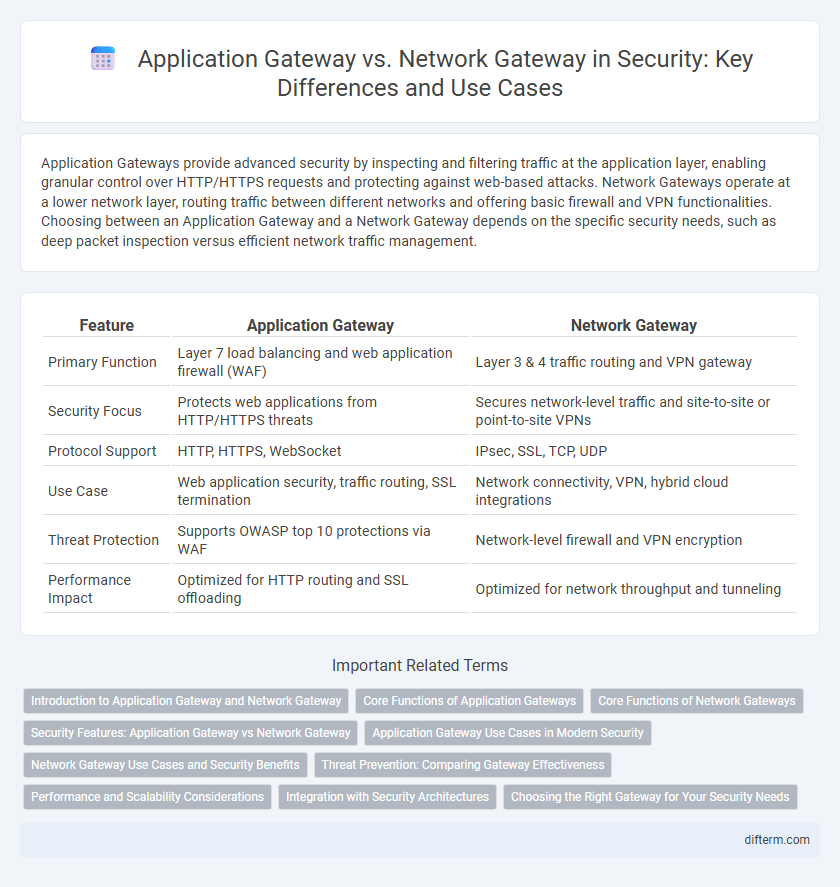Application Gateways provide advanced security by inspecting and filtering traffic at the application layer, enabling granular control over HTTP/HTTPS requests and protecting against web-based attacks. Network Gateways operate at a lower network layer, routing traffic between different networks and offering basic firewall and VPN functionalities. Choosing between an Application Gateway and a Network Gateway depends on the specific security needs, such as deep packet inspection versus efficient network traffic management.
Table of Comparison
| Feature | Application Gateway | Network Gateway |
|---|---|---|
| Primary Function | Layer 7 load balancing and web application firewall (WAF) | Layer 3 & 4 traffic routing and VPN gateway |
| Security Focus | Protects web applications from HTTP/HTTPS threats | Secures network-level traffic and site-to-site or point-to-site VPNs |
| Protocol Support | HTTP, HTTPS, WebSocket | IPsec, SSL, TCP, UDP |
| Use Case | Web application security, traffic routing, SSL termination | Network connectivity, VPN, hybrid cloud integrations |
| Threat Protection | Supports OWASP top 10 protections via WAF | Network-level firewall and VPN encryption |
| Performance Impact | Optimized for HTTP routing and SSL offloading | Optimized for network throughput and tunneling |
Introduction to Application Gateway and Network Gateway
Application Gateway operates at the application layer (Layer 7), inspecting and filtering incoming traffic based on HTTP/HTTPS protocols to enhance web application security and performance. Network Gateway functions at the network layer (Layer 3 or 4), managing and routing traffic between different networks while enforcing broad security policies like IP filtering and VPN connectivity. Application Gateways provide granular control over user requests, whereas Network Gateways focus on securing and directing network-level data flows.
Core Functions of Application Gateways
Application Gateways provide advanced security by inspecting application layer traffic, enabling protocol-specific filtering, and enforcing user authentication before granting access to resources. They operate at Layer 7 of the OSI model, allowing granular control over application protocols such as HTTP, FTP, and DNS, thereby preventing sophisticated attacks like SQL injection and cross-site scripting. Unlike Network Gateways that route data between networks at Layer 3 or 4, Application Gateways focus on deep packet inspection and content filtering to protect web applications and sensitive data.
Core Functions of Network Gateways
Network gateways primarily serve as the connection point between different networks, enabling secure data transmission and protocol translation, essential for maintaining network integrity. They perform core functions such as traffic filtering, packet inspection, and routing, ensuring efficient flow and security enforcement across diverse network environments. Network gateways also facilitate VPN connections and act as firewalls, providing robust access control and threat mitigation at the network boundary.
Security Features: Application Gateway vs Network Gateway
Application Gateways provide granular security by inspecting and filtering traffic at the application layer, enabling advanced threat detection such as SQL injection and cross-site scripting protection. Network Gateways focus on securing data packets at the network layer, offering features like firewall filtering, VPN termination, and IP address management. Application Gateways enhance security with deep packet inspection, while Network Gateways ensure perimeter defense and encrypted communication channels.
Application Gateway Use Cases in Modern Security
Application Gateway excels in modern security by providing granular control over HTTP/S traffic, enabling advanced Layer 7 filtering, SSL termination, and web application firewall (WAF) integration to protect against common threats like SQL injection and cross-site scripting. It is ideal for securing web applications, managing API traffic, and enforcing authentication policies with deep packet inspection. Unlike Network Gateways that primarily handle Layer 3 and 4 traffic routing, Application Gateways focus on application-level security, ensuring robust protection for cloud-native and microservices architectures.
Network Gateway Use Cases and Security Benefits
Network gateways serve as critical access points that manage data flow between different networks, enhancing security by enforcing strict traffic filtering and protocol inspection. Use cases include securing remote access via VPNs, segmenting network zones to prevent lateral movement of threats, and enabling secure connections for IoT devices. Their security benefits stem from granular control over inbound and outbound traffic, threat detection capabilities, and minimizing exposure to cyber attacks through robust authentication and encryption mechanisms.
Threat Prevention: Comparing Gateway Effectiveness
Application Gateways provide advanced threat prevention by inspecting and filtering traffic at the application layer, detecting vulnerabilities like SQL injection and cross-site scripting. Network Gateways focus on packet-level filtering and firewall rules, offering broad perimeter defense but limited deep inspection capabilities. For comprehensive threat prevention, Application Gateways offer superior protection against sophisticated attacks targeting specific applications.
Performance and Scalability Considerations
Application Gateways optimize performance by inspecting and routing traffic at the application layer, enabling fine-grained control and enhanced security for web applications, which supports scalable deployment in cloud environments. Network Gateways operate at the network layer, providing high throughput and low latency for general traffic routing but with less granular control, making them suitable for large-scale network connectivity with predictable performance. Scalability is achieved in Application Gateways through dynamic resource allocation and SSL offloading, while Network Gateways rely on load balancing and high-capacity hardware to handle increased network traffic efficiently.
Integration with Security Architectures
Application Gateways integrate seamlessly with web application firewalls (WAFs) and identity management systems, providing granular control over HTTP/HTTPS traffic and enabling deep packet inspection for enhanced threat detection. Network Gateways support broader security architectures by facilitating IPsec VPNs, firewall policies, and intrusion detection/prevention systems (IDS/IPS), securing data at the network layer. Both gateways complement zero trust models by enforcing access controls and monitoring traffic flow tailored to application-level or network-level security requirements.
Choosing the Right Gateway for Your Security Needs
Application Gateway offers advanced Layer 7 traffic inspection with deep packet analysis, making it ideal for web application security and protection against attacks like OWASP Top 10 threats. Network Gateway operates at Layer 3 or 4, providing efficient routing and basic security features such as IP filtering and VPN support for secure network connectivity. Choosing the right gateway depends on whether your priority is granular application-level security or high-performance network routing and access control.
Application Gateway vs Network Gateway Infographic

 difterm.com
difterm.com